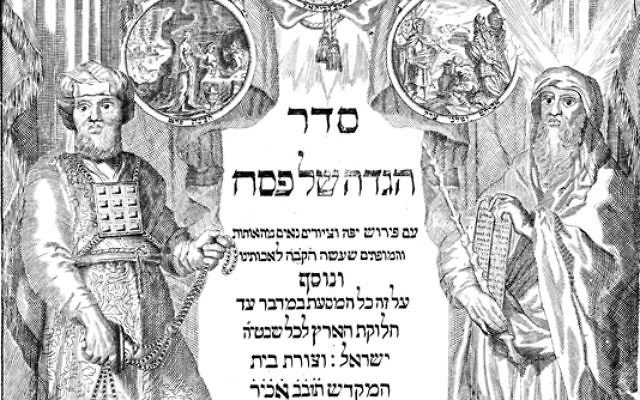Haggadot Come Home to Emory
By M. Patrick Graham/ libmpg@emory.edu
Each spring Emory Hillel and Chabad work to be sure that all Jews on the Emory campus are able to observe Passover by means of the seder and other religious services. This year the Tam Institute of Jewish Studies (Emory) has collaborated with library staff to offer a new experience: an exhibition of historic and contemporary haggadot in the new gallery of the Pitts Theology Library.

“Reading the Telling: The Passover Haggadah Across Time and Place” is curated by doctoral student Adam T. Strater. It opened March 7 and runs through June 30. It is open to the public at no charge during regular library hours.
What Will I See?
The setting for the exhibition is one of the newest and finest spaces on the Emory campus: a gallery of 1,200 square feet with 22 custom exhibit cases, illuminated by a combination of fiber-optic and LED lighting. Large graphic panels complement and enhance the select examples of rare and exquisite haggadot, along with key examples of the more familiar and modern pieces. Materials are drawn from the collections of the Pitts Library, the Rose Library (Emory), the William Breman Jewish Heritage Museum and private Atlanta collectors. Among the featured items:
- The first three editions of the illustrated Amsterdam Haggadah (1695, 1712, 1781), produced by a convert to Judaism and exerting more influence than any that followed.
- L ’Haggadá Illustrata, published in Trieste in 1864, has been acclaimed by scholars as the most distinguished illustrated haggadah in 19th century Europe.
- The Poona Haggadah (India, 1874) was printed for the second-largest community of Jews in India and presents illustrations that are distinctively Indian in appearance.
- The Rainbow Haggadah was published in 1945 for the 42nd Infantry Division’s Passover seder in Dahn, Germany, shortly before Germany’s surrender.
- A 1947 kibbutz haggadah that presents Holocaust imagery.
- An Israeli military haggadah from 1948.
- The Freedom Seder of 1969, which marked an effort by Jews to connect with African-Americans after the assassination of Martin Luther King Jr.
- The “Third Annual Women’s Seder Haggadah” (Rachel Simon, 2004) illustrates an annual women’s event sponsored by the Marcus Jewish Community Center.
- Facsimiles of the historic Rylands and Prague haggadot (14th and 16th centuries, respectively), and the beautiful Jerusalem (1997) and Moss (2007) haggadot.
What Will I Learn?
For those who have eaten the seder meal and held a haggadah, some of the materials in the exhibit may seem familiar and bring back memories of childhood. These very items, though, will appear novel to many of the children who tour the exhibit.
New to all, however, will likely be the beautiful folio copy of the first illustrated Amsterdam Haggadah (1695) and all the others that join forces to illustrate the magnificent achievement of the haggadah to transmit and guide the Passover observance to each new generation, wherever Jews found themselves and in whatever languages they spoke. The illustrations show a certain continuity as they present the biblical story, but they also attest artistic vitality and flexibility as they appeal to new places, cultures and times.
The exhibit treats the history of the haggadah, explains key terminology, rehearses Passover observance in Atlanta, discusses cultural and ideological versions of the haggadah, and takes up the motif of the four sons and important artistic renderings of the haggadah.
Visitors will leave the gallery struck by the power of the Exodus story, its potential for representation to and engagement by successive generations, and the inspiration of haggadot produced in times of great hardship and suffering.
The Backstory
This exhibit would never have occurred without the contributions of men and women devoted to Passover observance and to the haggadah.
Rabbi David Geffen, author of the “American Heritage Haggadah” (1992) and grandson of Rabbi Tobias Geffen, longtime leader of Congregation Shearith Israel after immigrating to America from Lithuania in 1903, gave his collection of about 100 haggadot to the Pitts Library in 2007 and continued to support the library’s work in this area even after he made aliyah.
The Geffen donation was followed by the gift of Richard Goldstein’s 580 haggadot in 2008. Goldstein was a Jewish social worker in Hollywood, Fla., and his daughter, Lauren Azoulai, connected him with the Pitts Library and suggested that it would be a suitable home for his collection.
Azoulai described the growth of her father’s collection: “Anyone who has known Dick well over these many years has been recruited into a special army — an army of haggadah soldiers. Wherever we are and wherever we traveled, we were always on the quest for more haggadot.”
Others have donated haggadot to Pitts, and the library has purchased historic imprints at New York auctions.
So Emory invites you to visit the campus this spring with family and friends and let this exhibit enrich your Passover observance. It may well spark a few new questions and commentary at your seder table.
M. Patrick Graham is the Margaret A. Pitts professor of theological bibliography at the Pitts Theology Library in Emory University’s Candler School of Theology.




comments